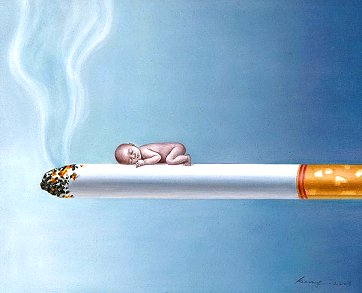ARTnews
Six 21st Century Chinese Neo-Pop Artists
ArtSpace/Virginia Miller Galleries, Coral Gables (Miami), FL
by Richard Speer

Working in a neo-Pop style, the six Chinese artists in this group show variously celebrated and critiqued the Westernization currently transforming China’s economic and sociopolitical landscape. This pairing of style and theme proved well-suited to Pop’s matchless facility for communicating a wry detachment from, and simultaneous breathless engagement with, the consumerism and self-absorption of the West.
In his paintings of the coveted male baby in one-child Chinese familes, Kang Can positions the tykes on the precipice of sundry jeapardies: an enormous burning cigarette, the lip of a beer mug, an artery-clogging jumbo cheeseburger. Floating before flat, Mel Ramos-like backgrounds, the guileless babes seemed to stand in for endangered national traditions in the infancy of China’s economic boom.
Painter Li Bo deployed similarly flat backgrounds behind objects lined up side by side, irrespective of proportion: an AK-47 the same size as a potted flower, a schoolgirl, and a human heart. These created a coded, pictographic commentary on hot-button issues facing the country: human rights violations, drug trafficking, prostitution, and organ harvesting.
Taking a different tack, two artists collaged images from historical and modern China, not always effectively. Lu Peng’s gouache works on rice paper tended toward an unvaried palette and compositional fussiness that detracted from their impact, whereas Liu Yan’s more spacious approach served her mixed-media works well: punk rockers and thong-clad strippers juxtaposed with traditional Chinese domestic scenes, as in the nudgingly provocative The Man’s World.
Yang Na and Xiong Lijun contributed the show’s most exuberant, least conceptual pieces: anime-influenced portraits of doe-eyed glamour girls with pouty lips and overzealous mascara. Lijun’s paintings, with their pinks and acid greens, were especially garish, their titles (Look at Me; Sunny Kiss; Spice Girl) capturing the eye-widening vacuity that continues to make Pop—and the Western experience—so seductive.
—Richard Speer
BACK TO RICHARD'S ARTNEWS REVIEW MENU
BACK TO RICHARD'S WELCOME PAGE
BACK TO RICHARD'S RESUME